A Study Of The 1914 Durango 1 Centavo And 5 Centavos
by Scott Doll
Introduction
The coins minted in Durango during the Mexican Revolution are for the most part very crude, poor quality and generally ugly in appearance. However, two particular issues from Durango were quite different than the normal revolutionary issues since these were well struck, high relief and high quality.
Although the coins were shipped to the border and placed on the Mexican National Railroad to be sent to Durango, it is believed that most of the coins may have remained unclaimed, thus never circulated and were confiscated by the railroad and sold after the war.
Most of these coins can be easily found at auctions and coin shows in high grade; also on occasions some specimens, usually in circulated condition, can be found with a variety of obverse and reverse counterstamps, and some of the 5 centavos are also seen with silver or possibly nickel plating. These changes are believed to have been made after the Revolution so the coins could be used as tokens or for some other unknown reason; therefore they do not have any revolutionary significance.
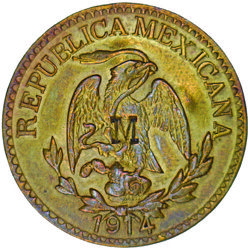
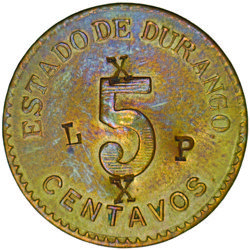
GB-139, A-DO 110 struck in brass with obverse & reverse counterstamps
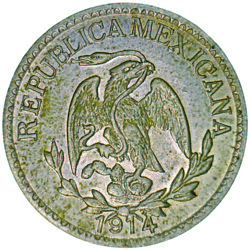
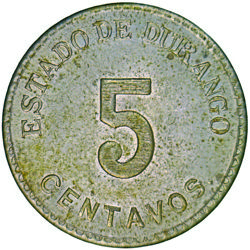
GB-139, A-DO 110 struck in brass with silver or nickel plating
The aluminum one centavo is catalogued by Guthrie and BothamleyBothamley, Merril and Guthrie, Hugh. Mexican Revolutionary Coinage 1913-1917. Beverly Hills, CA: Superior Stamp and Coin Co., 1976. as GB-113 and in another recent publication, Compendio de la Moneda de la Revolución Mexicana by Carlos Abel Amaya GuerraAmaya G., Carlos Abel. Compendio de La Revolución Mexicana. Monterrey, NL México, 2010. as A-DO 57. It is approximately 21mm in size and has not been reported in any other metal besides aluminum.
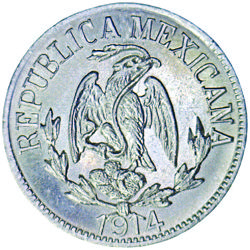
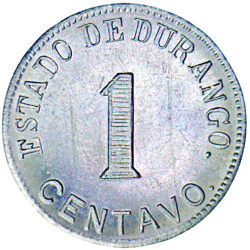
GB-113, A-DO 57 struck in aluminum
The 5 centavos coin is approximately 26mm in size. Most specimens were minted in brass; however a much smaller number were struck in copper. An undated lead specimen also exists and is approximately 29mm in size.
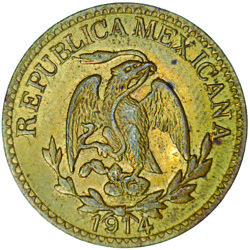

GB-139, A-DO 110 (Amaya misclassified GB-139 as A-DO 106) struck in brass
Although Guthrie-Bothamley did not mention any die varieties, there are at least two commonly known obverse and reverse dies used to strike the 5 centavos. These varieties have been known for some time by many collectors, although not formally documented until recently in Amaya’s book. There is also a third obverse variety; however it has not been documented to any level of detail in past publications. More study is needed on this obverse variety since it appears to be a new variety or it may simply be an early die version or work in progress of one of the other two obverse dies. Thus far it has only been seen on a crudely struck lead planchet which is more than likely a trial strike. The differences in the various obverse and reverse dies are very subtle, but can be easily recognized upon closer inspection.
Analysis of the 5 centavos obverse die varieties
Characteristics of obverse die variety 1

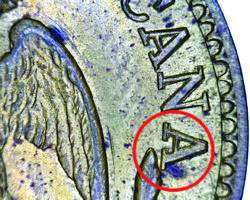

Attribute #1-1 Attribute #1-2 Attribute #1-3

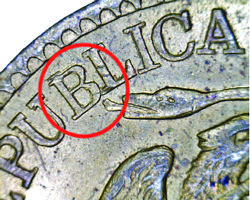
Attribute #1-4 Attribute #1-5
Attribute #1-1 – Letters “ME” of “MEXICANA” is level with one another at the base.
Attribute #1-2 – Last “A” of “MEXICANA” is very close to the tip of the right outermost leaf.
Attribute #1-3 – “9” of the date (1914) almost touches a fat branch hanging down.
Attribute #1-4 – Tool mark missing on the right leg of the letter “R” of “REPUBLICA”.
Attribute #1-5 – Tool mark at the top left of “B” of “REPUBLICA”; letters “B” and “L” are touching at the base; snake tongue very close to the base of the letter “B”.
Characteristics of obverse die variety 2
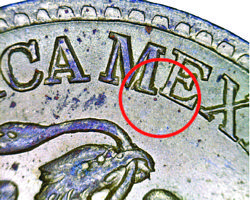
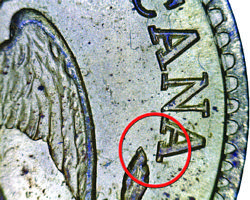
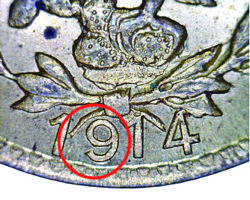
Attribute #2-1 Attribute #2-2 Attribute #2-3
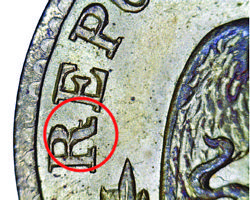
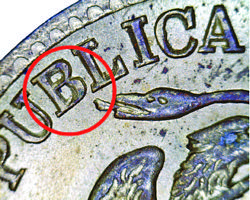
Attribute #2-4 Attribute #2-5
Attribute #2-1 – Letters “ME” of “MEXICANA” is uneven at the base with one another; therefore “E” is slightly higher than the letter “M”.
Attribute #2-2 – Last “A” of “MEXICANA” has a wider gap with the tip of the right outermost leaf than on obverse die variety 1.
Attribute #2-3 – “9” of the date (1914) has a wide gap between it and a thin branch hanging down compared to obverse die variety 1.
Attribute #2-4 – Tool mark on the right leg of the letter “R” of “REPUBLICA” protruding slightly outward toward the letter “E”.
Attribute #2-5 – Tool mark missing at the top left of “B” of “REPUBLICA”; letters “B” and “L” have a gap at the base; snake tongue is not as close to the base of the letter “B” compared to obverse die variety 1.
Characteristics of obverse die variety 3
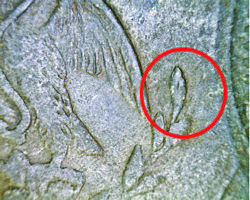
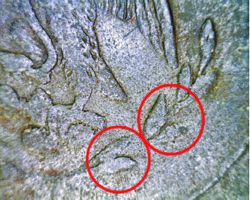
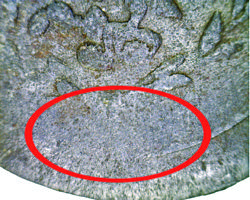
Attribute #3-1 Attribute #3-2 Attribute #3-3
Attribute #3-1 – Last “A” of “MEXICANA” is not close to the tip of the right leaf; however the legend may not be visible in this area due to the double strike on the sample coin.
Attribute #3-2 – Leaves on the right side are disposed 2-2-2-1; as opposed to 3-3-2-1 as seen on obverse die varieties 1 and 2.
Attribute #3-3 – Date (1914) is missing.
Analysis of the 5 centavos reverse die varieties
Characteristics of reverse die variety A

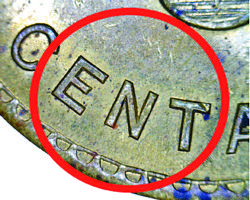

Attribute #A-1 Attribute #A-2 Attribute #A-3
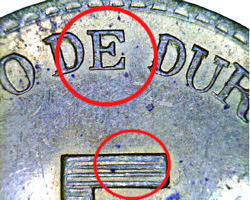
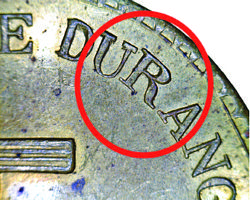
Attribute #A-4 Attribute #A-5
Attribute #A-1 – Small tool mark on the inner curve of the number 5 (denomination).
Attribute #A-2 – “ENT” of “CENTAVOS” is evenly spaced.
Attribute #A-3 – “STA” of “ESTADO” is evenly spaced.
Attribute #A-4 – “E” of “DE” is upright (not tilted); the number 5 (denomination) has two shading marks within the upper bar of the digit.
Attribute #A-5 – Bottom right foot of letter “R” and left foot of the letter “A” of “DURANGO” has a wide gap.
Characteristics of reverse die variety B
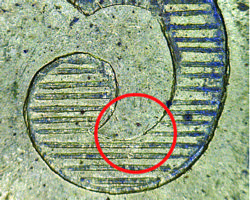
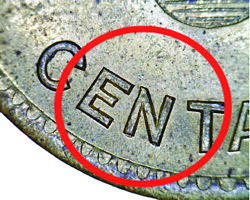
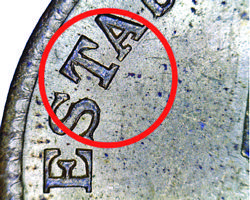
Attribute #B-1 Attribute #B-2 Attribute #B-3
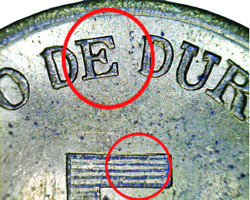
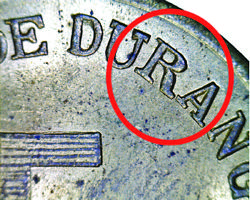
Attribute #B-4 Attribute #B-5
Attribute #B-1 – Small tool mark on the inner curve of the number 5 (denomination) is missing.
Attribute #B-2 – “ENT” of “CENTAVOS” is not evenly spaced and letters “EN” are very close to one another.
Attribute #B-3 – “STA” of “ESTADO” is not evenly spaced and “TA” are very close to one another at the top.
Attribute #B-4 – “E” of “DE” is tilted to the left; the number 5 (denomination) has three shading marks within the upper bar of the digit.
Attribute #B-5 – Bottom right foot of letter “R” and left foot of the letter “A” of “DURANGO” has a very narrow gap and almost touches each other at the base.
Die Combination Varieties and Rarity
The 1 centavo has only been documented in aluminum using one set of dies. It is a very common coin and can easily be found in Uncirculated to Brilliant Uncirculated condition. There are at least three commonly known die varieties or die combinations for the 5 centavos coins and one additional lesser known die combination with a new obverse.
Die Variety #1 (obv. 1 / rev. A)
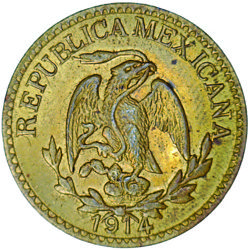
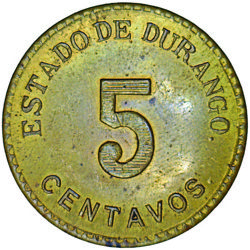
Die Variety #1 (obv. 1 / rev. A): GB-139, A-DO 110 struck in brass
This is probably the most common of the known varieties and is readily available in Uncirculated condition for the brass variety. The copper variety with this die combination is very scarce and seldom seen in auctions or at coin shows.
Die Variety #2 (obv. 1 / rev. B)

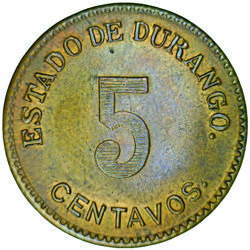
Die Variety #2 (obv. 1 / rev. B): GB-UNL, A-DO 106 struck in brass
This appears to be the least common of the known varieties in brass and although considered a common coin, it can be a challenge to find in Uncirculated condition. This die combination is not known to exist in copper.
Die Variety #3 (obv. 2 / rev. B)
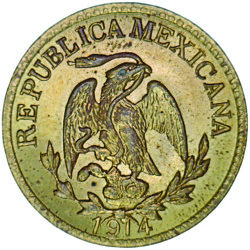
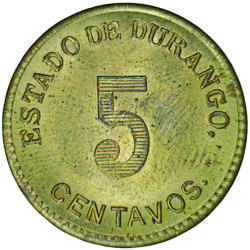
Die Variety #3 (obv. 2 / rev. B): GB-UNL, A-DO 111 struck in brass
Like obv. 1 / rev. A, this is a common die combination and can easily be found in Uncirculated condition in brass; however this die combination is not known to exist in copper.
Die Variety #4 (obv. 3 / rev. B)
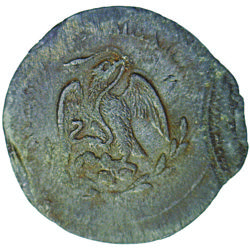
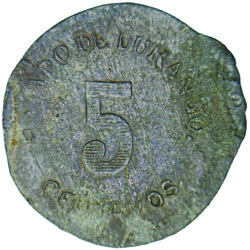
Die Variety #4 (obv. 3 / rev. B): GB-UNL, A-DO UNL struck in lead
This is a very rare die combination and has only been seen on what is believed to be a trial strike in lead. The obverse may be a new die or possibly an early working die for obverse 1 or 2.
Amaya’s classifications of the 5 centavos varieties differ somewhat from this author’s opinion, based on detailed analysis of actual coins and comparisons to coin scans in Amaya and Guthrie-Bothamley. The following chart should help lessen any confusion with the die varieties and cross reference information.
| Die Variety | Composition | GB # | Amaya # | Rarity & Comments |
| Obv. 1 / Rev. A | brass | 139 | 110 | Common. Amaya’s A-DO 110 has the die variety which matches GB-139 (not A-DO 106). |
| copper | 140 | UNL | Very Scarce. Amaya does not reference a copper specimen for this die variety; however it is documented with photos in GB. Amaya’s A-DO 107 is probably intended as a reference to this particular coin (GB-140). |
|
| Obv. 1 / Rev. B | brass | UNL | 106 | Common. Amaya’s A-DO 106 does not have a die variety match with GB where this die variety is unlisted. |
| copper | UNL | 107 | Does not exist. This die variety in copper is unlisted in GB and is not known to exist. Amaya’s A-DO 107 is probably intended as a reference to GB-140 (obv. 1 / rev. A). | |
| lead | UNL | 109 | Does not exist. This die variety in lead is unlisted in GB and is not known to exist. Amaya’s A-DO 109 is probably intended as a reference to unlisted variety (obv. 3 / rev. B) in lead. | |
| Obv. 2 / Rev. B | brass | UNL | 111 | Common. This die variety was unknown to GB but catalogued by Amaya. |
| Obv. 3 / Rev. B | lead | UNL | UNL | Very Rare. Neither GB nor Amaya document this combination since they were not aware of obverse 3, though Amaya’s A-DO109 is probably intended as a reference to this particular coin in lead. |
